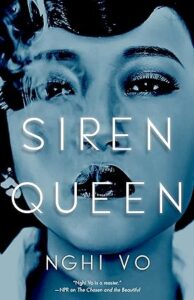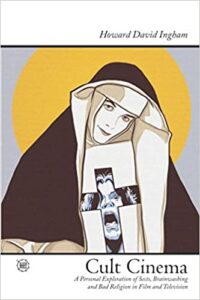Siren Queen by Nghi Vo
Tor.com, 2022
ISBN-13 : 978-1250788832
Available: Hardcover, paperback, library binding, KIndle edition, audiobook
Buy: Bookshop.org | Amazon.com
This is not so much a horror novel as it is an homage to classic monster movies and a critique of golden-age Hollywood. Readers looking for blood and gore will not find it here. What they will find is a dark, beautifully written warning about the dangers of ambition. Told in first person by the protagonist, the story reads like a memoir.
CK is a Chinese-American girl obsessed with acting in the movies, at the beginnings of the talkies. She is working bit parts for children off the books for a director at Wolfe Studios, who wants to present her as his new discovery once she turns 18. CK is impatient and tracks down a retired actress who gives her information that will get her an audience, and a contract, with Oberlin Wolfe, using blackmail photos. Due to this leverage she is able to demand that she not be cast in stereotypical roles for Asian women (an issue faced by real-life Chinese-American actress Anna May Wong in this time period).. She takes the stage name Luli Wei, a name that happens to also be her sister’s.
Getting a studio contract is similar to making a bargain with faeries. In exchange for fame and fortune, the studio owner controls your life (this is a fairly accurate description of the Hollywood studio system at the time, even without faeries’ involvement). There’s even a version of Tam Lin that takes place within the story.
Directors don’t know how to cast CK since she can’t be cast in stereotypical roles, but finally she is cast as a monster, the Siren Queen, and the movie and its sequels are blockbuster hits. Despite her ability to cause scandal and her defiance, the studio can’t get rid of her. CK has a lesbian romance with rising star Emmaline Sauvignon which the studio ends because it interferes with their narrative of the kind of person Emmaline is supposed to be. Later, she gets involved with a scriptwriter hired to do edits on the script of the last Siren Queen movie.
Despite knowing her contract would eventually have negative consequences for her, I couldn’t help loving CK for her ambition and refusal to let studio officials and directors walk on her, and for her own love of playing the role of a vengeful monster and loving it. The classic monster movies are clearly an inspiration to the author, and the critique of racist stereotypes and queer erasure in casting at that time is something I am glad to see brought to the attention of modern readers. Highly recommended.
Reviewed by Kirsten Kowalewski









Follow Us!